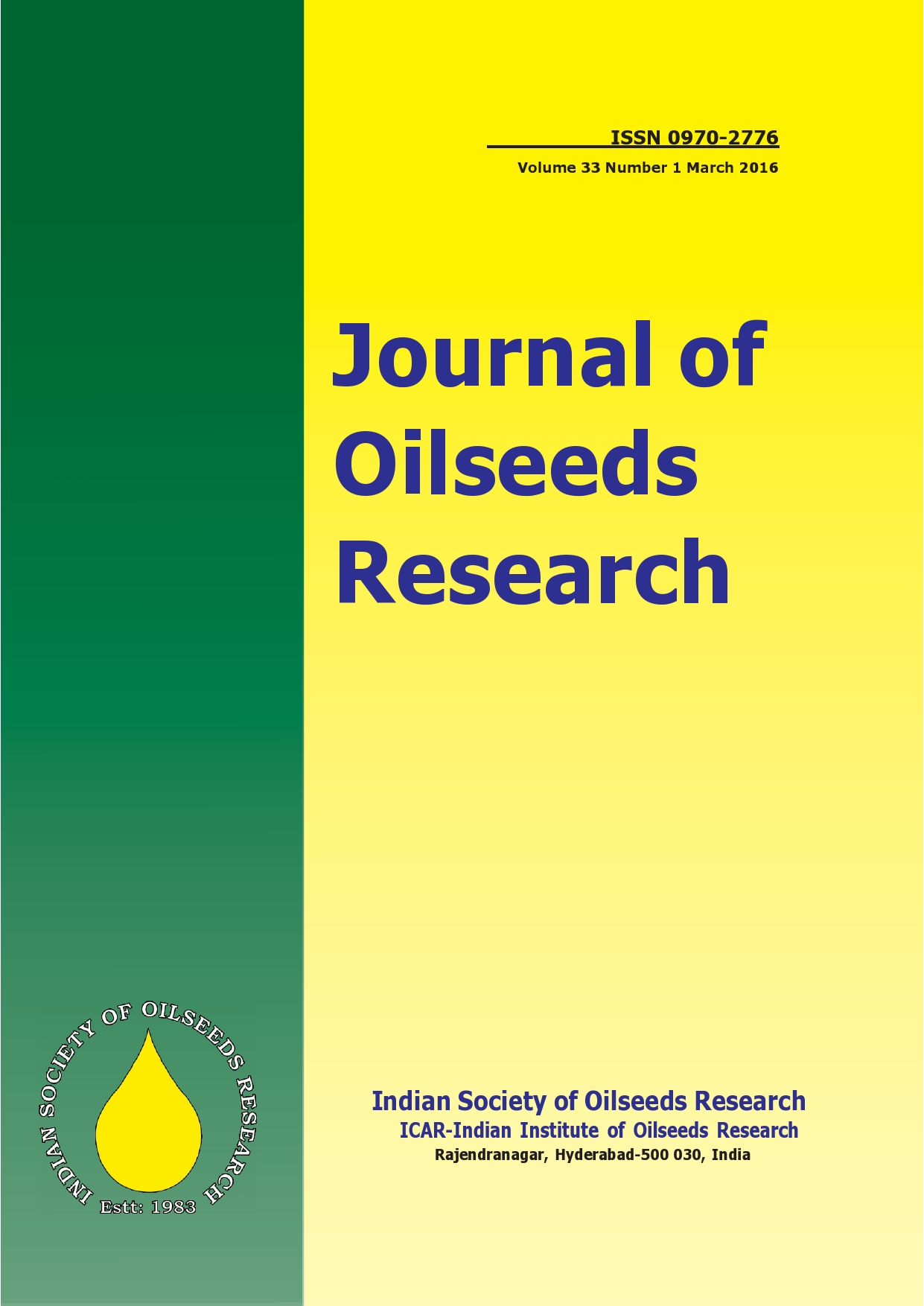Maximum entropy modelling for predicting the potential distribution of wild sesame, Sesamum alatum Thonn. in India
MAXIMUM ENTROPY MODELLING FOR PREDICTING POTENTIAL DISTRIBUTION OF WILD SESAME
83 / 0
Keywords:
GIS, Ecological niche modelling, Maxent, Sesamum alatumAbstract
Ecological niche modelling or predictive habitat distribution framework for wild sesame, Sesamum alatum Thonn., an important wild taxa occurring in India has been analyzed using Maximum Entropy method. The model indicated that parts of Kanyakumari, Thoothukudi, Sivaganga, Pudukottai, Coimbatore, Thiruvalluvar districts of Tamil Nadu and Chittoor, Kadapa, Nellore, Prakasam, Guntur, Krishna, West Godavari, East Godavari, Visakhapatnam districts of Andhra Pradesh are falling under high probability regions for climate suitability of S. alatum species where the in-situ conservation and other genetic resources activity could be taken up in the changed climatic regime. Mean temperature of coldest quarter (30.4%), annual mean temperature (26.0%) and mean diurnal range (17.7%) are major bioclimatic variables contributing to the climatic model of the wild sesame.
Downloads
References
Chamaille L, Tran A, Meunier A, Bourdoiseau G, Ready P and Dedet J P 2010. Environmental risk mapping of Canine leishmaniasis in France. Parasites and Vectors, 3: 3-31.
David A K, Keith L, Mc Dougall, Christopher C S and Jillian L W 2012. Spatial analysis of risks posed by root rot pathogen, Phytophthora cinnamomi: Implications for disease management. Proceedings of the Linnean Society of New South Wales, 134: 147-180.
Elith J, Graham C H, Anderson R P, Dudík M, Ferrier S, Guisan A, Hijmans R J, Huettmann F, Leathwick R, Lehmann A, Li J, Lohmann, L G, Loiselle B A, Manion G, Moritz C, Nakamura M, Nakazawa Y, Overton J, Peterson A T, Phillips J, Richardson K, Scachetti-Pereira R, Schapire E, Soberon J, Williams S, Wisz M and Zimmermann E 2006. Novel methods improve prediction of species' distributions from occurrence data. Ecography, 29: 129-151.
Fourcade Y, Engler J O, Rodder D and Secondi J 2014. Mapping species distributions with MAXENT using a geographically biased sample of presence data: a performance assessment of methods for correcting sampling bias. PLoS One, 9(5): e97122. doi:10.1371/journal.pone.0097122.
Gormley A M, Forsyth D M, Griffioen P, Lindeman M, Ramsey D S L, Scroggie M P and Woodford L2011. Using presence-only and presence-absence data to estimate the current and potential distributions of established invasive species. Journal of Applied Ecology, 48: 25-34.
Hijmans R J and Graham C 2006. The ability of climate envelope models to predict the effect of climate change on species distributions. Global Change Biology, 12: 2272-2281.
Hooker J D 1885. The Flora of British India, Vol. IV, Reeve & Co. Ltd, The East House Brook, Kent, England, Reprint edition, BSI, India, pp. 386-387.
Khoury C K, Heide B, Castañeda-Álvarez N P, Achicanoy H A, Sosa C, Miller R E, Scotland R W, Wood J R I, Rossel G, Eserman L A, Jarret R L, Yencho G C, Bernau V, Juarez H, Sotelo S, de Haan S and Struik P C2015. Distributions, ex-situ conservation priorities, and genetic resource potential of crop wild relatives of sweet potato [Ipomoea batatas (L.) Lam., I. series Batatas]. Frontiers in Plant Science, 6: 251.
Kumaraswamy H H, Jawaharlal J, Ranganatha A R G and Chander Rao S. 2015. Safe sesame (Sesamum indicum L.) production: Perspectives, practices and challenges. Journal of Oilseeds Research, 29(1): 1-24.
Pearson R G, Raxworthy C J, Nakamura M and Peterson A T 2009. Predicting species distributions from small numbers of occurrence records: a test case using cryptic geckos in Madagascar. Journal of Biogeography, 34: 102-117.
Petersen M J 2013. Evidence of a climatic niche shift following North American introductions of two crane flies (Diptera; genus tipula). Biological Invasions, 15: 885-897.
Phillips S J, Anderson R P and Schapire R E 2006. Maximum entropy modelling of species geographic distributions. Ecological Modelling, 190: 231-259.
Phillips S J, Dudik M and Schapire R E 2004. A Maximum Entropy Approach to Species Distribution Modelling. In: Proceedings of the Twenty-First International Conference on Machine Learning, Banff, Canada, pp. 655-662.
Phillips S J and Dudik M 2008. Modeling of species distributions with Maxent: newextensions and a comprehensive evaluation. Ecography, 31: 161-175.
Ranganatha A R G, Lokesha R, Tripathi A, Tabassum A, Paroha S and Shrivastava M K. 2012. Sesame improvement: present status and future strategies. Journal of Oilseeds Research, 29(1): 1-26.
Reddy M T, Hameedunnisa Begum, Neelam Sunil, Someswara Rao Pandravada, Natarajan Sivaraj 2015. Assessing climate suitability for sustainable vegetable Roselle (Hibiscus sabdariffa var. sabdariffa L.) cultivation in India usingMaxent Model. Agricultural and Biological Sciences Journal, 1(2): 62-70.
Reddy M T, Begum H, Sunil N, Pandravada S R, Sivaraj N and Kumar S 2015. Mapping the climate suitability using Maxent modeling approach for Ceylon spinach (Basellaalba L.) cultivation in India. The Journal of Agricultural Sciences, 10(2): 87-97.
Roura-Pascual N, Brotons L, Peterson A T and Thuiller W 2009. Consensual predictions of potential distributional areas for invasive species: a case study of Argentine ants in the Iberian Peninsula. Biological Invasions, 11: 1017-1031.
Solhjouy-Fard S, Sarafrazi A, Moeini M M and Ahadiyat A 2013. Predicting habitat distribution offive heteropteran pest species in Iran. Journal of Insect Science, 13: 116.
Tittensor D P, Baco A R, Brewin P E, Clark M R, Consalvey M, Hall-Spencer J, Rowden A A, Schlacher T, Stocks K I and Rogers AD 2009. Predicting global habitat suitability for stony corals on seamounts. Journal of Biogeography, 36:
-1128. Villordon A, Njugana W, Simon G, Philip N, Heneriko K, Simon C J, Don L B, Bernard Y, Phinehas T and Robert O M M 2006. Using GIS based tools and distribution modelling to determine sweet potato exploration and documentation priorities in Sub-Saharan Africa. Horticultural Science, 41(6): 1377-1381.
Yost A C, Petersen S L, Gregg M and Miller R 2008. Predictive modeling and mapping sage grouse (Centrocercus urophasianus) nesting habitat using maximum entropy and a long-term dataset from Southern Oregon. Ecological Informatics, 3: 375-386.
Zimmermann H, Loos J, Wehrden H and Fischer J 2015. Aliens in Transylvania: risk maps of invasive alien plant species in Central Romania. Neo Biota, 24: 55-65.
